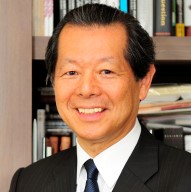Members
The Asia-Pacific Leadership Network for Nuclear Non-Proliferation and Disarmament (APLN) has over one hundred members from eighteen countries across Asia and the Pacific, consisting of former political, diplomatic and military leaders, senior government officials, and scholars and opinion leaders. APLN aims to inform and energize public opinion, especially high-level policymakers, to take seriously the very real threats posed by nuclear weapons, and to do everything possible to achieve a world in which they are contained, diminished and eventually eliminated.

FUNABASHI Yoichi
Co-Founder and Chairman of the Asia Pacific Initiative
Funabashi Yoichi is a former journalist and editor-in-chief of the Asahi Shimbun, and a correspondent to Beijing and Washington DC. He has written extensively on foreign affairs, the US-Japan Alliance, economics and historical issues in the Asia Pacific.
Funabashi Yoichi is an award-winning Japanese journalist, columnist and author. He has written extensively on foreign affairs, the US-Japan Alliance, economics and historical issues in the Asia Pacific.
He has a distinguished career as a journalist. He served as correspondent for the Asahi Shimbun in Beijing (1980-81) and Washington (1984-87), and as US General Bureau Chief (1993-97). In 2016 he became the first Japanese laureate of Stanford University’s prestigious Shorenstein Journalism Award. In 2013 he won the Oya Soichi Nonfiction Award for his book on the Fukushima Daiichi Nuclear Accident ‘Countdown to Meltdown,’ he won the Japan Press Award known as Japan’s “Pulitzer Prize” in 1994 for his columns on international affairs, his articles in Foreign Affairs and Foreign Policy won the Ishibashi Tanzan Prize in 1992 and in 1985 he received the Vaughn-Ueda Prize for his reporting on international affairs.
His books in English include: The Peninsula Question (Brookings Institution Press, 2007); Reconciliation in the Asia-Pacific, ed. (USIP, 2003,); Alliance Tomorrow, ed. (Tokyo Foundation, 2001); Alliance Adrift (Council on Foreign Relations Press, 1998, winner of the Shincho Arts and Sciences Award); Asia-Pacific Fusion: Japan’s Role in APEC (Institute for International Economics, 1995, winner of the Mainichi Shimbun Asia Pacific Grand Prix Award); and Managing the Dollar: From the Plaza to the Louvre (1988 winner of the Yoshino Sakuzo Prize).
As Co-founder and Chairman of the Rebuild Japan Initiative Foundation he oversaw the “Independent Investigation Commission on the Fukushima Daiichi Nuclear Accident” (Routledge, 2014) that was ranked in the top 24 policy reports produced by a think-tank in the ‘2012 Global Go-to Think Tank Ranking.’ Since its establishment in 2012, RJIF has published several influential reports on a broad range of key policy challenges facing Japan and the Asia-Pacific. These include: Japan’s Population Implosion: The 50 Million Shock (Shinchosha, 2015); Examining Japan’s Lost Decades (Routledge, 2015); The Decline of Postwar Moderate Conservatism in Japan (Kadokawa Shinsho, 2015); Anatomy of Yoshida Testimony (RJIF, 2015); Quiet Deterrence: Building Japan’s New National Security Strategy, (RJIF 2014); Japan in Peril? 9 Crisis Scenarios (CLSA, 2014); DPJ Administration: Challenges and Failures (Chuokoron Shinsha, 2013).
He received his B.A. from the University of Tokyo in 1968 and his Ph.D. from Keio University in 1992. He was a Nieman Fellow at Harvard University (1975-76), a visiting Fellow at the Institute for International Economics (1987), a Donald Keene Fellow at Columbia University (2003), a visiting professor at the University of Tokyo Public Policy Institute (2005-2006) and a distinguished guest professor at Keio University (2011-2014). He previously served on the board of The International Crisis Group, and is a member of the Trilateral Commission. He is a former contributing editor of Foreign Policy, and sits on the editorial board of The Washington Quarterly.
His articles and papers in English include: “Japan’s Silver Pacifism” (The National Interest, Jan/Feb 2016); “What will the TPP mean for China” (China File, 9 October 2015); “What is America’s Purpose? (The National Interest, Sept/Oct 2015); “Japan’s Gray-Haired Pacifism” (The International New York Times, 13 August 2015); “Japan needs to think big on Asian strategy” (East Asia Forum, 21 June 2015); “The west can look for answers in Japan’s lost decades” (Financial Times, 1 May 2015); “Japan Must Join China’s Bank” (The International New York Times, 23 April 2015); “A futile boycott of China’s bank will not push Xi out of his back yard” (Financial Times, 9 December 2014); “Fukushima in review: a complex disaster, a disastrous response” (Bulletin of the Atomic Scientists, March/April 2012); “Lessons from Japan’s nuclear accident” (East Asia Forum, 26 March 2012); “The end of Japanese illusions”(New York Times, 11 March 2012); “My findings in Japan’s existential fallout” (Financial Times, 9 March 2012); “Fukushima in review: A complex disaster, a disastrous response” (Bulletin of the Atomic Scientists” (1 March 2012); “Challenges for Rising Asia and Japan’s Role” (Yale Global Online, September 2010); “Forget Bretton Woods II: the Role for U.S.-China-Japan Trilateralism” (Washington Quarterly, April 2009); “No One Model for Global Economy” (Yale Global Online, March 2009); “Keeping Up With Asia” (Foreign Affairs, September/October 2008); “Power of Ideas: The US is Losing its Edge” (Global Asia, Fall 2007); “Stuck on the Sidelines”, (Newsweek International, 5 March 2007); “Koizumi landslide: the China factor” (Yale Global Online, 15 September 2005); “The world should also have a vote”(International Herald Tribune, 25 March 2004); “Koizumi opens a Pandora’s box”(Financial Times, 7 January 2004); “China is preparing a ‘peaceful ascendancy’ ” (International Herald Tribune, 30 December 2003); “Learning from five years of trialogue” (China-Japan-US: Meeting New Challenges, 2002); “Northeast Asia’s strategic dilemmas” (Assessing the Threats, 2002); “Asia’s digital challenge”(Survival, Spring 2002); “Japan’s unfinished success story” (Japan Quarterly 2001); “Japan’s moment of truth” (Survival, Winter 2000-01); “International perspectives on national missile defense: Tokyo’s temperance” (The Washington Quarterly, Summer 2000); “Tokyo’s depression diplomacy” (Foreign Affairs, November / December 1998); “Thinking trilaterally” (China-Japan-US: Managing the Trilateral Relationship, Japan Center for International Exchange, 1998); and “Bridging Asia’s economics-security gap” (Survival, Winter 1996-97).
